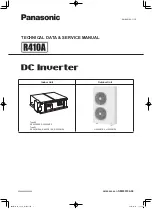
15V (12V battery). Including a safety margin, the midpoint deviation should therefore remain below 2% during charging. When, for
example, charging a 24V battery bank at 28.8V absorption voltage, a midpoint deviation of 2% would result in:
Therefore:
Obviously, a midpoint deviation of more than 2% will result in overcharging the top battery and undercharging the bottom battery.
These are two good reasons to set the midpoint alarm level at not more than d = 2%.
This same percentage can be applied to a 12V battery bank with a 6V midpoint.
In case of a 48V battery bank consisting of 12V series connected batteries, the % influence of one battery on the midpoint is
reduced by half. The midpoint alarm level can therefore be set at a lower level.
9.4. Alarm delay
In order to prevent the occurrence of alarms due to short term deviations that will not damage a battery, the deviation must
exceed the set value during 5 minutes before the alarm is triggered. A deviation exceeding the set value by a factor of two or
more will trigger the alarm after 10 seconds.
9.5. What to do in case of an alarm during charging
In case of a new battery bank the alarm is usually due to differences in the initial state of charge of the individual battery. If the
deviation increases to more than 3% you should stop charging the battery bank and charge the individual batteries or cells
separately. Another way is to substantially reduce the charge current to the battery bank, this will allow the batteries to equalize
over time.
If the problem persists after several charge-discharge cycles do the following:
• In case of series-parallel connection disconnect the midpoint, parallel connection wiring and measure the individual midpoint
voltages during absorption charging to isolate batteries or cells which need additional charging.
• Charge and then test all batteries or cells individually.
In case of an older battery bank which has performed well in the past the problem may be due to systematic undercharge. In this
case more frequent charging or an equalization charge is needed. Please note that only flooded deep cycle flat plate or OPzS
batteries can be equalized. Better and regular charging will solve the problem.
In case there are one or more faulty cells:
• In case of series-parallel connection disconnect the midpoint, parallel connection wiring and measure the individual midpoint
voltages during absorption charging to isolate batteries or cells which need additional charging.
• Charge and then test all batteries or cells individually.
9.6. What to do in case of an alarm during discharging
The individual batteries or cells of a battery bank are not identical, and when fully discharging a battery bank, the voltage of some
cells will start dropping earlier than others. The midpoint alarm will therefore nearly always trip at the end of a deep discharge.
If the midpoint alarm trips much earlier (and does not trip during charging), some batteries or cells may have lost capacity or may
have developed a higher internal resistance than others. The battery bank may have reached the end of service life, or one or
more cells or batteries have developed a fault:
• In case of series-parallel connection, disconnect the midpoint parallel connection wiring and measure the individual midpoint
voltages during discharging to isolate faulty batteries or cells.
• Charge and then test all batteries or cells individually.
Manual - SmartShunt
Page 30
Midpoint voltage monitoring







































